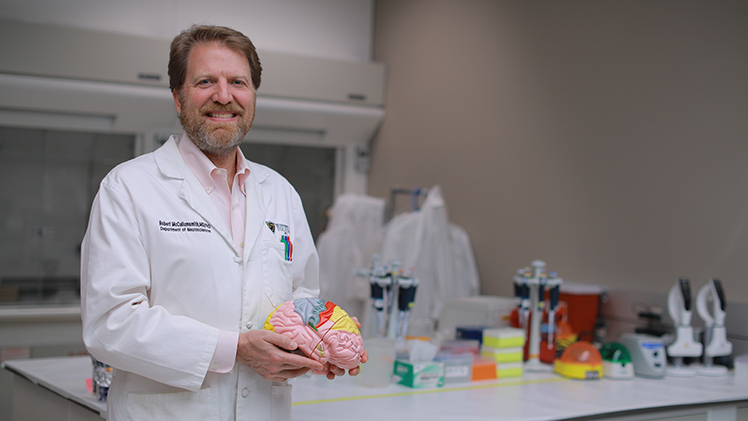Researchers at The University of Toledo hope to unlock new clues about the starting point and progression of Alzheimer’s disease by casting aside previous assumptions and taking a clean-slate approach to the disease.
Though Alzheimer’s has been heavily studied for decades, clinical trials on potential treatments have overwhelmingly failed, said Dr. Robert Smith, professor and chair of the Department of Neurosciences and Psychiatry.

A new $3.7 million federally funded study led by Dr. Robert Smith, professor and chair of the Department of Neurosciences and Psychiatry, is hoped to unlock new clues about the starting point and progression of Alzheimer’s disease.
Only three drugs have U.S. Food and Drug Administration approval for the disease, and both run the risk of serious side effects in return for modest cognitive improvements.
“Alzheimer’s is a devastating disease and despite all the work that has been done, we still don’t have a solid grasp of how it develops or how we can safely and effectively treat it,” Smith said. “Clearly, we need a different approach.”
Smith recently was awarded a $3.7 million grant from the National Institute on Aging for a study that will analyze post-mortem brain samples from control individuals, individuals with mild cognitive impairment and individuals who received an Alzheimer’s diagnosis prior to their death.
Using cutting-edge tools, their lab will map out and compare the function of more than 500 individual kinase protein signaling pathways across those three subsets of brain tissue.
The project, Smith said, differs from previous research on the disease in both what scientists are looking at and in what they’re expecting to find.
Most federally funded research projects are formed around a single hypothesis. The work, more or less, is trying to further prove or disprove that idea.
UToledo researchers have no pre-set expectations.
“This is a hypothesis-generating project,” Smith said. “We have a lot of really good preliminary data and many potential targets, but we are coming at this with an open mind. Our study is completely agnostic to what everyone else is doing.”
UToledo’s team also is using a different method to measure what’s happening in the brain’s complex signaling pathways than other studies have employed.
Protein kinases, which are the enzymes Smith’s team is studying, add phosphates to proteins, changing their activity and creating complex regulatory networks. They allow for essential processes, but many of the 500-plus protein kinases in the human body are poorly understood, let alone well-studied in the context of Alzheimer’s disease.
By employing something called a kinome array, researchers can measure how much work protein kinase are doing within the brain’s signaling network, illuminating how its actions cascade through the brain.
Much of the existing literature, Smith said, has come from studies that looked only at how much of a protein was present in the brain — not its activity level.
“You can have no change in the amount of a protein with a big change in activity,” Smith said. “We are looking at Alzheimer’s in a way that it has never been looked at before, looking at parts of the genome that have never been looked at before. At the end of this study, we hope to have identified the cell types and the protein kinases that should be targeted for new drugs to block the progression of cognitive impairment seen in Alzheimer’s dementia. This is a moonshot project.”